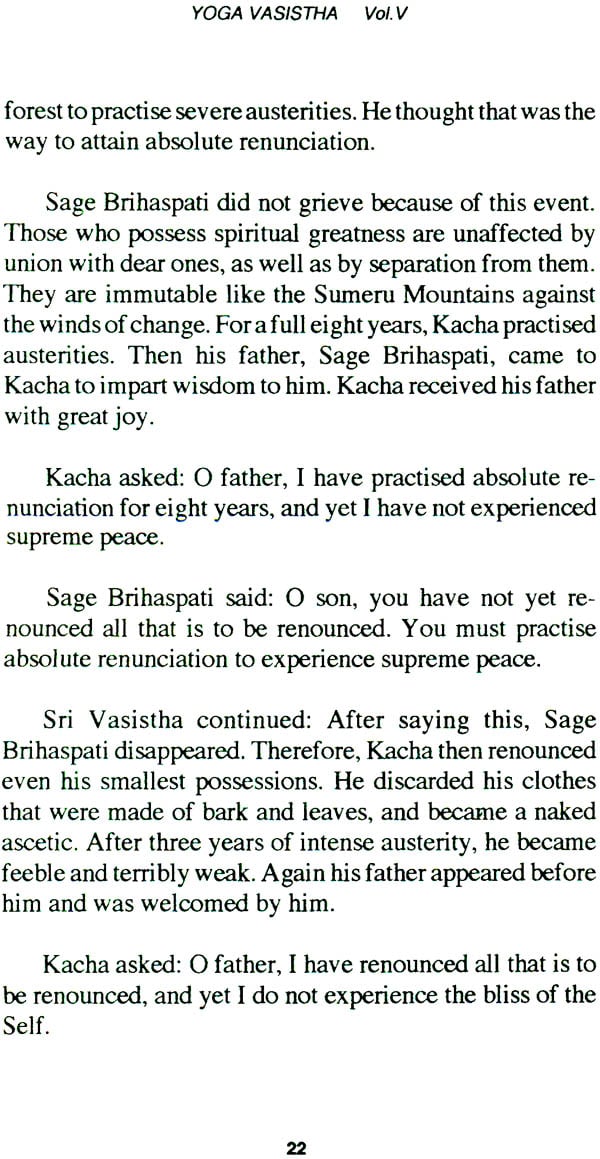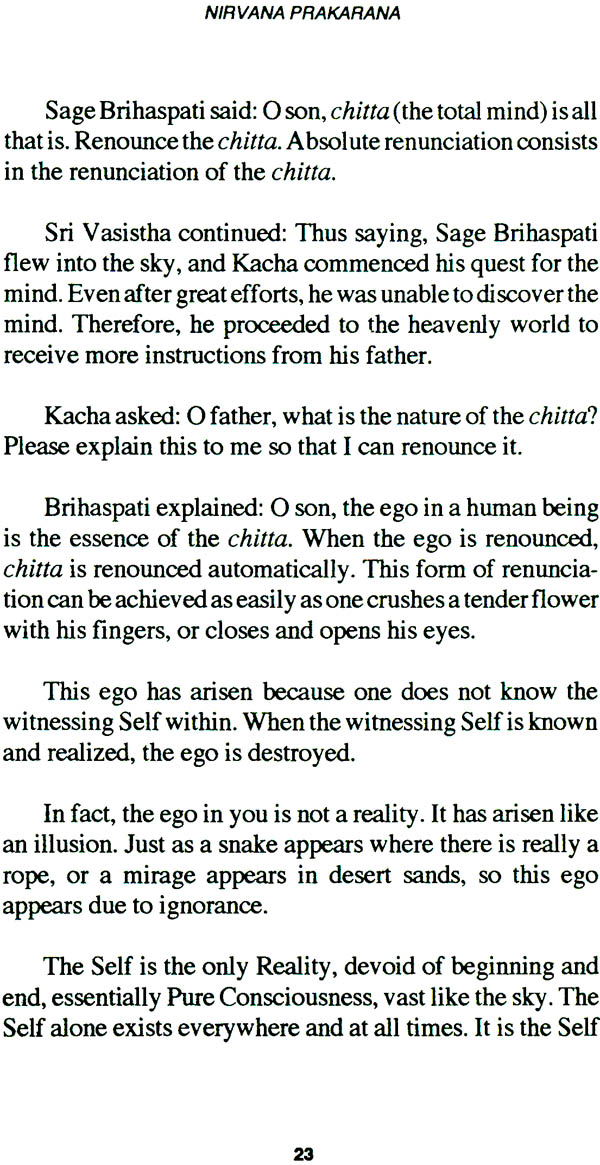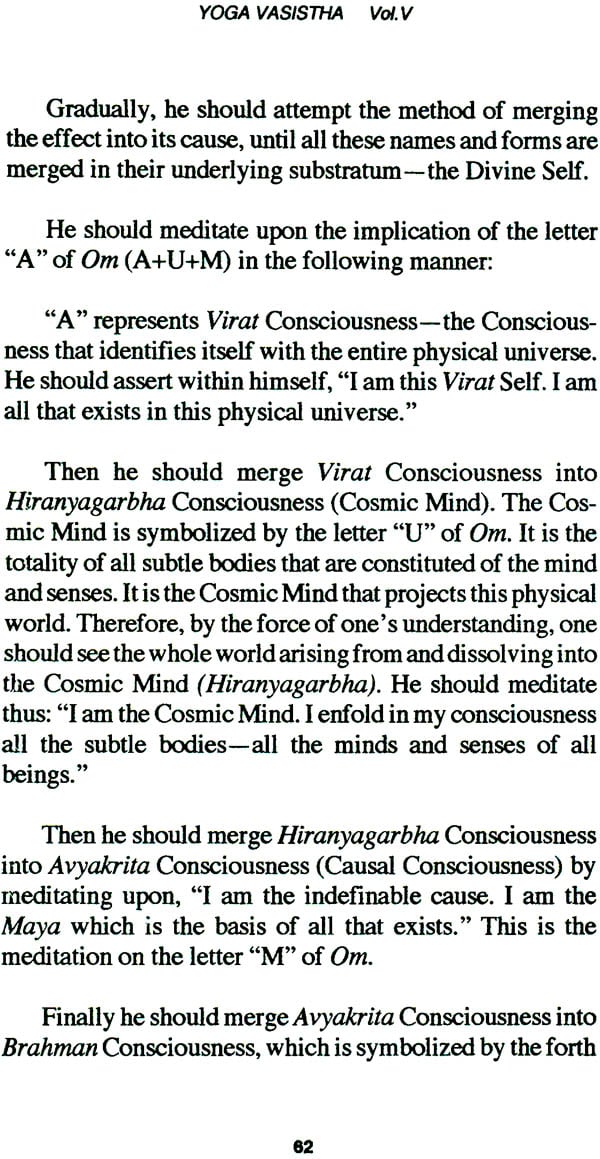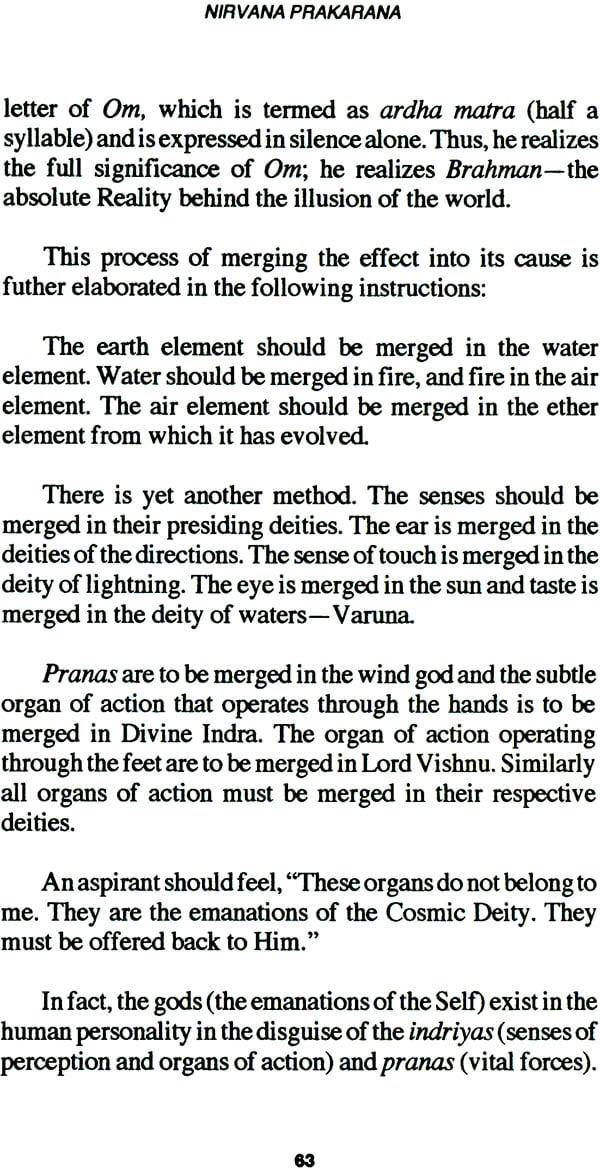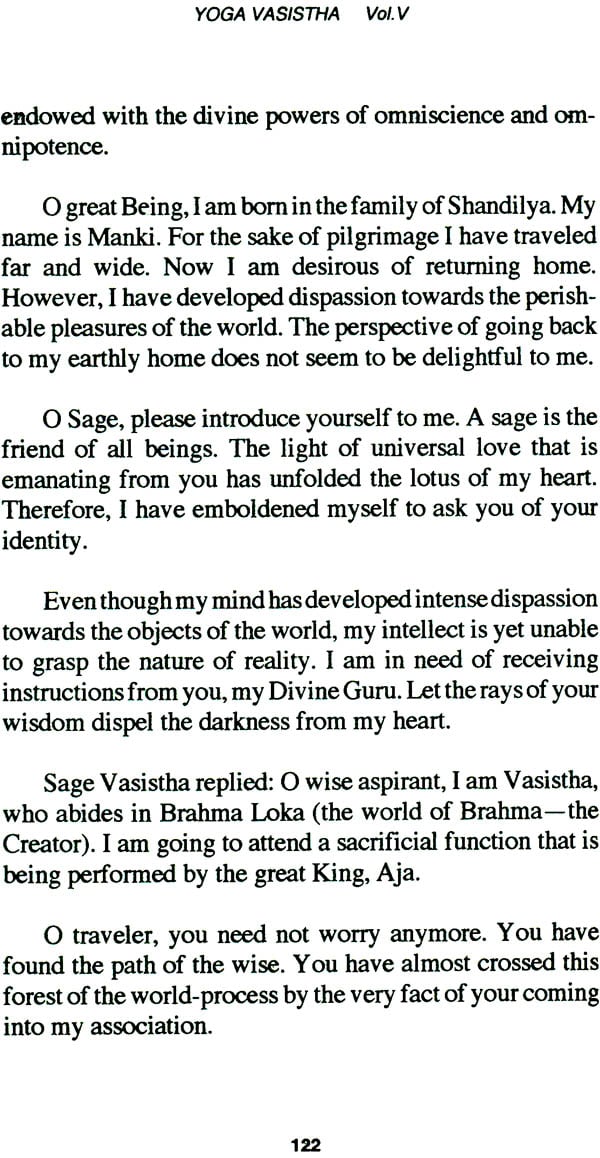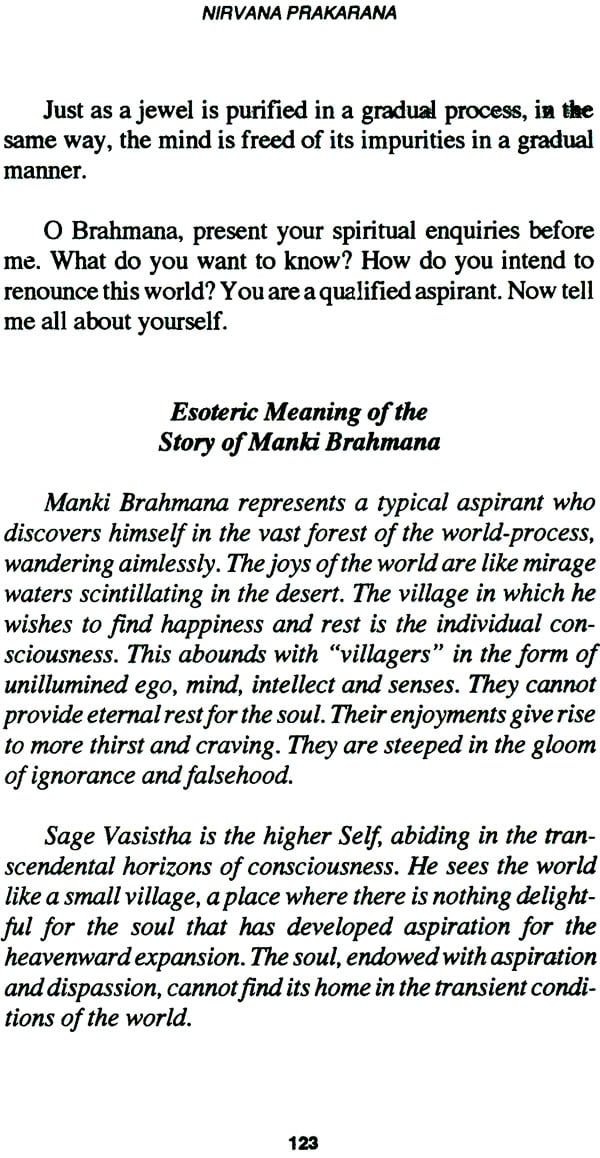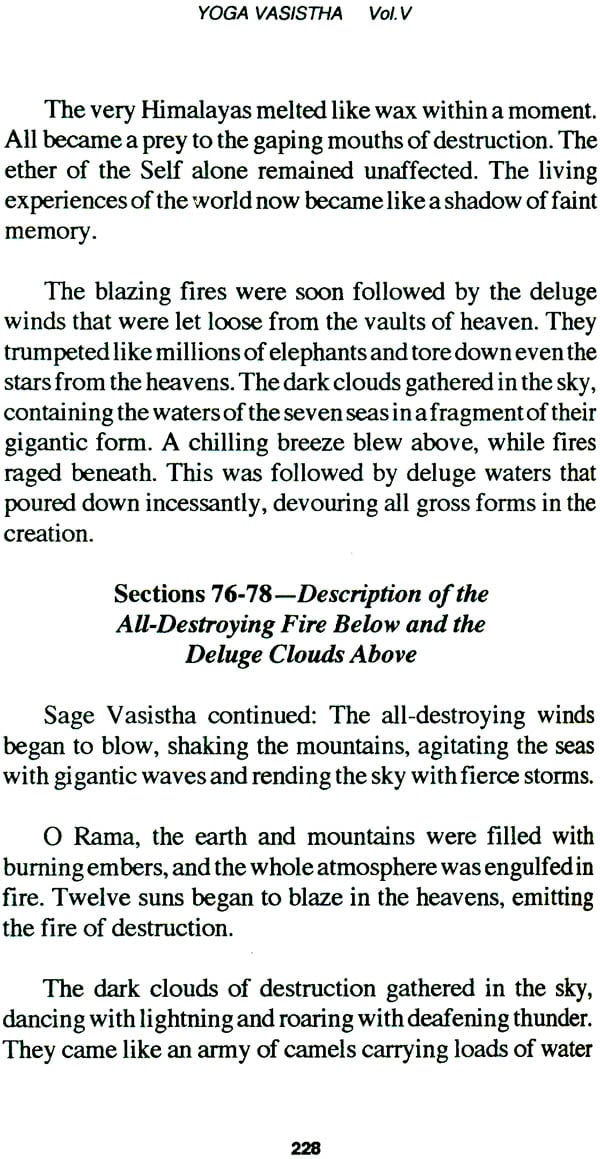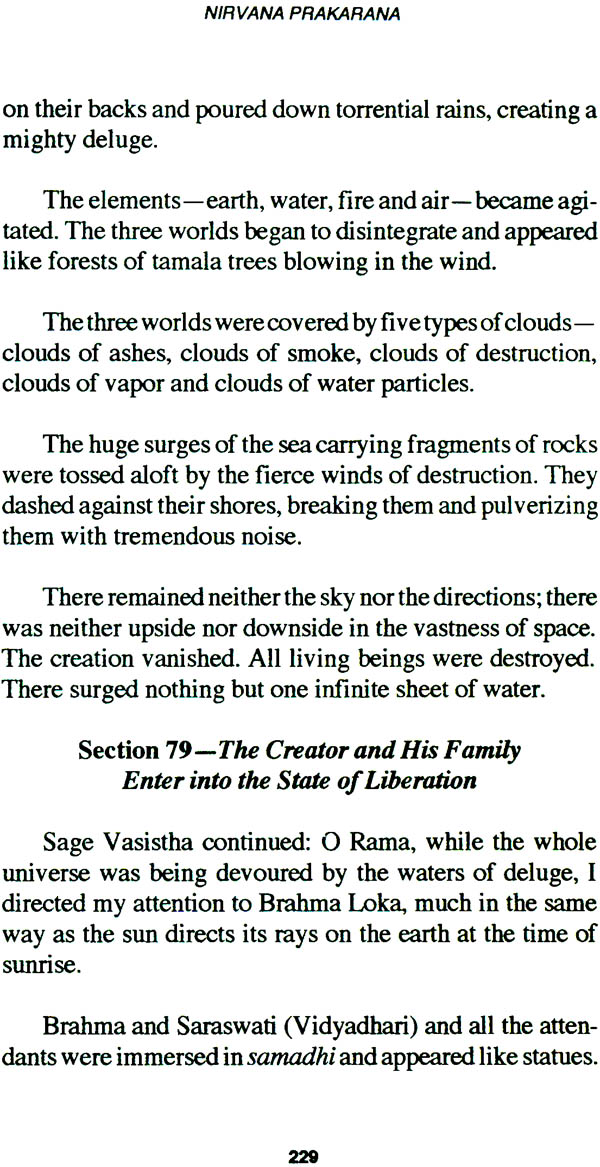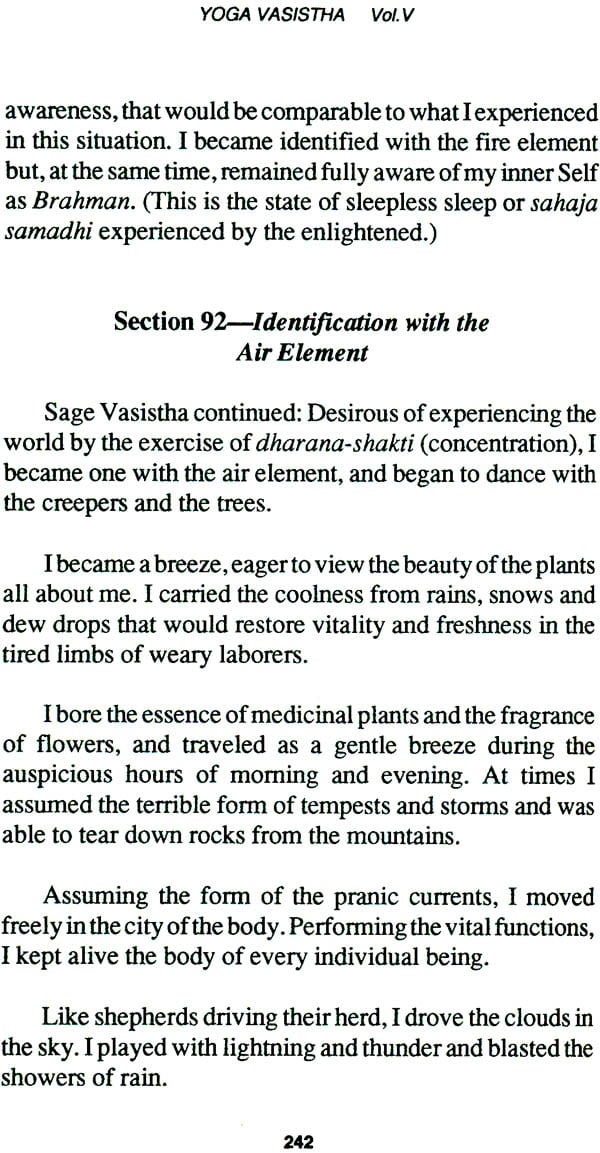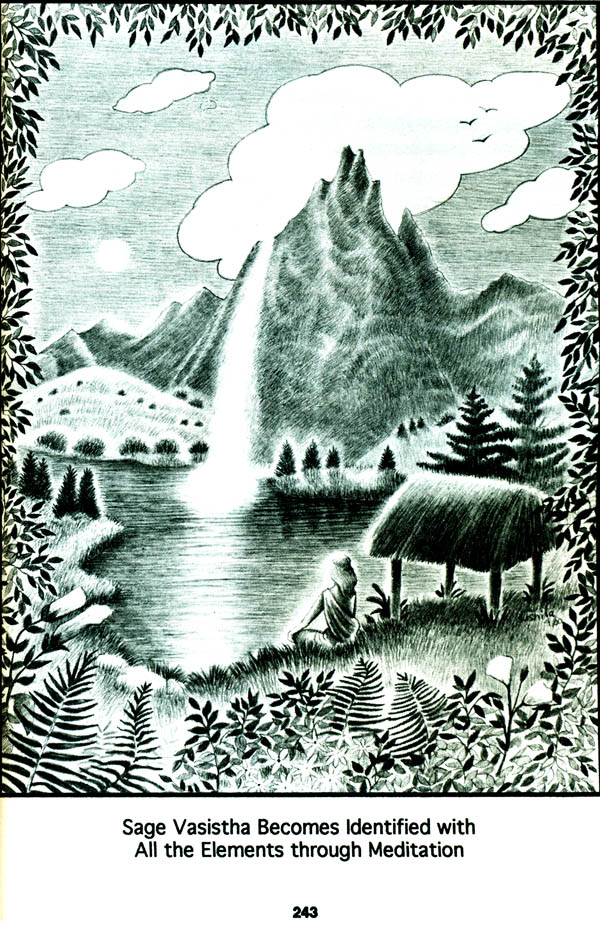
Yoga Vasistha (Volume V: Nirvana Purva-Uttarardha)
Book Specification
| Item Code: | IDC368 |
| Author: | Swami Jyotirmayananda |
| Publisher: | International Yoga Society |
| Language: | English |
| Edition: | 2000 |
| ISBN: | 093466434X |
| Pages: | 256 (9 B/W Illustrations) |
| Cover: | Paperback |
| Other Details | 8.3" X 5.3" |
| Weight | 280 gm |
Book Description
Publisher’s Note
Yoga Vasistha can bring a complete transformation in human personality; even like the beggar of old fairy tales who turned into a King when a charmed golden ring fell into his hand, just so, whosoever holds this book, turning the pages with an inquisitive mind and a heart searching for truth, will discover the infinite beauty of his inner Self. Yoga Vasistha nourishes the soul and awakens a yearning for freedom and an exquisite peace unknown before.
This unique book par excellence has been long awaited by advanced Vedantins and Yogis of India, because it is only available in rare editions of the last century. And it is what the enquiring mind of the West has been desperately needing since they heard the remarks of Schopenhauer, “In the whole world there is no study so beneficial and so elevating as that of the Upanishads. It has been the solace of my life; it will be the solace of my death.”
H. H. Sri Swami Jyotirmayananda, Internationally known lecturer and writer of over fifty books on Yoga and Vedanta philosophy, has been interpreting and commenting on Yoga Vasistha for over 30 years: first in India for 9 years at the Yoga Vedanta Forest Academy, Sivananda Ashram, Himalayas; in Vedantic conferences in Amritsar, Ludhiana, and other parts of India, and also in Dehradun Women’s College. Since coming to the West, Swamiji had been lecturing in Puerto Rico for six years, followed by his weekly lectures here in Miami. Available on cassette tapes, these lectures are an undying treasure.
Just as King Shah Jahan had the choice of only one type of food-grain while he was imprisoned for life, and he chose the garbanzo because of its nourishment and adaptability to a variety of tasty dishes, so too, if I could have only one book for some extraordinary reason to read for the rest of my life, I would choose Yoga Vasistha. After a brief encounter with Yoga Vasistha. After a brief encounter with Yoga Vasistha, the reader will feel that all other books of philosophy have become like old crumbs on the table, while Yoga Vasistha stands like the sweet and vitalizing elixir of life.
Unfortunately, however, due to the lack of knowledge of Yoga Vasistha, the intelligentsia of the West have been unable to realize the vast treasure of profound knowledge that lies hidden in this great work. Because of this reason, the wisdom of Vedanta has not been deeply understood and assimilated by them.
Yoga Vasistha encompasses in its powerful literature the dramatic stories of the inner states of the mind, and like a brilliant advocate, presents its brief with a convincing voice and expert phrasing. Yoga Vasistha has a mystic strategy that convinces the mind to undermine its fancies and imaginations leading to the realization that the world lies within the mind. Nothing is more inspiring and soul-stirring as when the mind lifts itself from the quagmire of false perceptions of the senses and sees the contents of waking, dream and deep sleep as the refraction of the Light of Consciousness filtering through the layers of egoistic illusions.
The awe-inspiring awakening of the knowledge that “You are not this body, not this mind, and not this intellect” is uplifting and produces a vital change in the overall perception of the world. It is for this reason Sages warn immature aspirants against the wrong interpretations of this grand philosophy; they emphasize the fact that the wisdom of the Yoga Vasistha must be received under the guidance of an illumined teacher. For those who are endowed with a mighty strength of intellect and intense dispassion, therefore, Yoga Vasistha brings for them the clouds of mystic understanding that bursts into the flood of unique bliss.
The greatest literatures of the world have always incorporated in their writings parables, illustrations and stories to bring about a striking impression, even like that of a flash of lightning upon the sleeping mind in order to awaken it sharply to the light of the truth. Yoga Vasistha abounds with these. Yoga Vasistha in its broad spectrum encompasses topics such as the mysteries of the soul, death and reincarnation, the subtle operations of the unconscious mind which bring about repeated embodiments, the psychic powers, the mystic energy known as Kundalini, and the techniques of spiritual enquiry and meditation. A studious reader, therefore, will meet for the first time a challenge to his intellect to discover the secret wealth of the Self, and to explore the mysteries of the mind.
It is to be noted that humor and wit permeate the writings and lectures of Sri Swami Jyotirmayananda, much like the green creeper adorning the tree of Liberation. But behind this, Sri Swami Jyotirmayananda gives to the world his most memorable writing which has been guarded as a secret mystic wealth by the Sages of India for a long time. This book, by Sri Swami Jyotirmayananda, presents you with the key to heavenly bliss and perfection, and every page of this book is filled with his blessings.
May the golden sun of your eternal Self rise from behind the horizon of distractions and mental limitations and encompass you in the greatest of beauty and sublime love which are the very essence of your real Self!
Introduction
In the “Bala-Kanda” section of the Ramayana it is stated that Sri Rama was given spiritual instructions by Sage Vasistha. Yoga Vasistha, a complete and separate work in itself, is that teaching. While the Ramayana, the epic poem more popularly known throughout India and the world, describes the life and adventures of Sri Rama, the Yoga Vasistha presents his inner realization in detail for those who wish to intensify their spiritual life and deepen their understanding. A vast work of approximately 32, 000 verses, the Yoga Vasistha was written by the great poet-sage Valmiki, as was the Ramayana, about 500 B.C. or earlier.
The Yoga Vasistha, which is virtually unknown in the West due to the scarcity of its English translations, is also known by the names of Maha-Ramayana, Uttar Ramayana, Arsha Ramayana, Jnana Vasistha, Vasistha Ramayana, and Vasistha. But whatever you choose to call it, it is the earliest detailed work of Yoga-Vedanta and gives a magnificent exposition of the subtleties and insights of that philosophy with a majestic sweep that has never been equaled in any metaphysical work since.
Every kind of exposition is employed in its presentation-didactic instruction, answers to doubts, parables, and stories within stories. Here, for example, the interlocking system of stories within stories enhances the vision of worlds within worlds, and of the infinitely complex world of the mind, itself arising from the Cosmic Mind. Many key points of this metaphysical instruction are touched upon over and over again with increasingly deeper meanings. Therefore the work appears to move in vast spirals, ultimately culminating in the Self-realization of Sri Rama.
In “Vairagya Prakaarana” of Volume I it will be remembered that Sage Vasistha asked Sri Rama to express the reasons for his depressed state of mind. At this, Sri Rama elaborated upon the transiency and essencelessness of all objects of the world. All that he once thought to be of value and a source of happiness has, through the vision of his penetrative intellect, become nothing but a source of emptiness and misery.
In the first chapter, therefore, Sri Rama has taken what is normally the most valued aspects of life and has shown how illusory they are. The purpose here is to promote dispassion (Vairagya) in the aspirant. Such Vairagya considers all pleasures of the world, from the lowest from of life to the highest-that of Brahma the Creator-as insignificant and illusory. This is the first and fundamental requirement of the path of wisdom that leads to Self-realization.
In the second chapter, “Mumukshu Prakarana,” it has been shown that certain qualifications are necessary for an aspirant before he can effectively move on the path towards the state of Immortality or Self-realization. Sage Vasistha, therefore, elaborated on the four most important qualifications-those of Serenity, contentment, Spiritual Enquiry and Good Association.
In addition, “Mumukshu Prakarana” elaborated on how the aspirant should not rely on destiny, rather on his own self-effort. The Self within is unlimited, and each person has that same potential within-all that is needed to unlock that infinite potential and creativity is repeated self-effort.
In the third chapter, “Utpatti Prakarana,” Sage Vasistha has shown how the world has evolved from and is sustained by the Absolute through the limitations of the mind. And since the world is merely a projection of the mind conditioned by ignorance, when ignorance is overcome by intuitive wisdom, mind rediscovers its unity with the Cosmic Mind and the individual merges into the Absolute. At this point, the entire world-process is remembered to be no thing but a long dream of the mind from which one has awaken.
The fourth chapter, “Sthiti Prakarana,” aims at steadying the knowledge of the Self. Giving insight into the amazing powers of the mind, Sage Vasistha explains that it is the impure mind that causes bondage, while it is the pure mind that gives Liberation. It is Brahman who has assumed the role of Jiva (an individual soul) due to the intensification of Vasanas (subtle desires). When freed of the Vasanas, the Jiva returns to its essential nature-Brahman. Just as with the dissolution of clouds the sun is fully revealed in the sky, so too, with the dissolution of Vasanas the knowledge of the Self becomes fully established in one’s heart.
In the fifth chapter, “Upashama Prakarana,” Sage Vasistha deals with the topic of the quiescence of the mind. With the increasing insight into the falsity of the world-process, the subtle desire of an aspirant begin to dissolve. Consequently, his consciousness goes on expanding until he is fully established in Self-realization. It is Vichar or spiritual enquiry which enlightens his mind. Vichar can be practiced by anyone whether he is a king like Janaka or an ascetic like Veethavya. Even demoniac personalities touched by the magic wand of Vichar may become transformed into enlightened Sages. In an eloquent style, abounding with stories and parables, Sage Vasistha gives a profound insight into the mystic art of Vichar which, having reached its maturity, blossoms into the intuitional realization of the Self.
In our second volume we covered “Utpatti Prakarana” (sections 66 to 122), the entire chapter of “Sthiti Prakarana” and a portion of “Upashama Prakarana” (sections 1 to 13). In the third volume we are covering the entire “Upashama Prakarana” from section 14 to section 93.
The sixth and the last chapter of Yoga Vasistha is “Nirvana Prakarana,” which is further divided into two parts: “Purvardha” (first half) and “Uttarardha” (second half). And “Uttarardha” (second half). In the fourth volume, we explored sections 1 to 110 of “Nirvana Prakarana-Purvardha.” In this fifth volume, we conclude 1-94 of “Nirvana Prakarana-Uttarardha,” In which Sage Vasistha’s teachings continue to soar to the sublimest heights of Vedantic wisdom.
About Swami Jyotirmayananda and his Ashram
Swami Jyotirmayananda is well-recognized as the foremost proponent of Integral Yoga, a way of life and thought that synthesizes the various aspects of the ancient Yoga tradition into comprehensive plan of personality integration.
Swami Jyotirmayananda has brought inspiration to thousands world-wide, yet still maintains an intimate setting at his main Ashram in Miami. A priviledged few have the honor of actually studying and working under the direct guidance of Swamiji.
Both the Yoga Research Foundation and the main Ashram lie in the southwest section of Miami, two minutes from the University of Miami and 15 minutes from the Miami International Airport. The Yoga Research Foundation is located in a commercial area, easily accessible from anywhere in the country. In addition to the lecture hall, the Foundation also houses a bookshop, offices, warehouse, press, computer and publication facilities.
The main Ashram is on a two and a half acre plot surrounded by trees and exotic plants, reminiscent of a forest hermitage such as those used by the ancient Sages. Adjoining are subsidiary Ashrams that house student/residents and Foundation guests. The grounds are picturesque, with tall green eucalyptus trees swaying with freedom in the winds, mango blooms spreading their aroma of sublimity, birds singing a song of eternal joy, and a lake of lotus blooms reflecting the expansion of the Heavens. Surpassing them all, however, is the holy presence of Sage Swami Jyotirmayananda that fills the atmosphere with a silent message powerful enough to change the very destiny of mankind.
In such an environment, the soul is nurtured and nourished, allowing for a total education and evolution of one’s Inner Self. With a Work/Study Scholarship students are able to attend all classes conducted by Swamiji tuition-free. In return, students devote their talents and expertise to the Foundation’s noble mission. Such opportunity is open to anybody who is devoted to the ideals of truth, non-violence and purity. If interested, write for more information.
| | 5 | |
| 111. | The Divine Sage Brihaspati Teaches His Son, Kacha | 21 |
| 112. | The Parable of a False Being | 24 |
| 113. | The Meaning of False Purusha | 26 |
| 114. | The Negation of the Concepts of Existence and Non-existence | 28 |
| 115. | The Characteristics of a Liberated Sage | 30 |
| 116. | Characteristics of a Dissolving Chitta | 35 |
| 117. | Prajapati Manu Instructs Ikshwaku | 37 |
| 118. | Methods of Attaining Self-realization | 38 |
| 119. | The Powers of Ignorance and Knowledge | 40 |
| 120. | Seven States of Wisdom Taught by Sage Manu | 41 |
| 121. | Two Types of Mental Attitudes | 43 |
| 122. | The Daily Conduct of an Enlightened Sage | 45 |
| 123. | Why Siddhis Are Not Desired by a Sage | 46 |
| 124. | Bondage and Liberation for the Individual Soul | 47 |
| 125. | Steadiness in Turiya Consciousness | 50 |
| 126. | The Seven States of Wisdom | 52 |
| 127. | Sage Valmiki Summarizes the Teachings for His Disciple Bharadwaja | 58 |
| 128. | The Path of Laya Yoga and Sri Rama’s Awakening | 61 |
| | ||
| 1. | Eradication of Desire in a Jivan Mukta | 72 |
| 2. | The World is Full of Shiva | 76 |
| 3. | Eradication of the World-Process | 79 |
| 4. | Eradication of the Ego-sense | 84 |
| 5. | The Need of Mastering the Senses (Sage Vasistha and Vidyadhara) | 87 |
| 6. | Miseries That Arise due to Sense-indulgence | 90 |
| 7. | The tree of the World-process Rising from the Seed of Ego | 94 |
| 8. | The World is a Vast Temple Created by Samkalpa | 96 |
| 9. | The World is Nothing but Pure Consciousness | 98 |
| 10. | The World Does Not Exist | 99 |
| 11. | Control of the Senses for Negating the World-process | 100 |
| 12. | The Ego-sense Is Illusory | 102 |
| 13. | Cosmos within an Atom | 103 |
| 14. | Story of the World within an Atom | 104 |
| 15. | Ego-the Seed of the World-process | 106 |
| 16. | Vidyadhara Attains Samadhi | 108 |
| 17. | The Fire that Burns the Seed of the world-process | 110 |
| 18. | The Illusory Worlds and the absolute Self | 111 |
| 19. | The Jivas and the Cosmic Being | 113 |
| 20-21 | Liberation is Attained by Piercing the Knot of the Ego | 114 |
| 22 | The Yoga of Bliss | 116 |
| 23 | The Story of Manki Brahmana | 119 |
| 24 | The Dispassion of Manki Brahmana | 124 |
| 25 | The seeds of the World-process and their Destruction | 126 |
| 26 | Bondage and Liberation | 130 |
| 27 | Instructions for Attaining Steadiness in the Self | 133 |
| 28 | The True Nature of Karma | 135 |
| 29 | A Sage Performs Actions and Is Yet Established in the Actionless Self | 137 |
| 30 | Description of that Spiritual Vision which Removes the Illusions of Multiplicity | 141 |
| 31 | All Objects Are Sustained by consciousness | 143 |
| 32 | Liberation Can Be Attained by the Practice of Good Association and Reflection | 146 |
| 33 | The Treatment of the Disease of the World-process | 148 |
| 34 | The World-process Vanishes by Not-Seeing | 150 |
| 35 | The Nature of Brahman | 152 |
| 36 | Desire is the Cause of Bondage | 155 |
| 37 | The Method of Wisdom for Overcoming Desires | 158 |
| 38-39 | The Nature of the Sage Who Is Established in Wisdom | 160 |
| 40 | The Double Consciousness of a Liberated Sage | 162 |
| 41 | The World Dances like a Puppet due to ignorance | 163 |
| 42 | The Self is to Be Worshipped by Discriminative Vision | 164 |
| 43 | The Manner is which the World Dissolves in Brahman | 166 |
| 44 | The Tree of Samadhi | 168 |
| 45 | The Ascent on the Tree of Meditation | 172 |
| 46 | The State of Mind after Eating the Fruit of the Samadhi Tree | 176 |
| 47 | The Means of Attaining Self-Realization | 179 |
| 48 | The Great Qualities that Arise due to Dispassion | 181 |
| 49 | The Greatness of the Wise | 184 |
| 50 | Seven Types of Jivas | 186 |
| 51 | Effacement of the World-Process from One’s Consciousness | 188 |
| 52 | The Self Appears as the World-Process | 190 |
| 53 | The State of Liberation | 192 |
| 54 | Non-Duality of the Self | 194 |
| 55 | The Absolute Point of View | 196 |
| 56 | The Parable of the World-within-a-Rock | 197 |
| 57-58 | The Negation of Egoism in a Sage | 199 |
| 59 | Sage Vasistha Views Numerous Universes | 201 |
| 60 | Sage Vasistha Ignores the Celestial Lady | 203 |
| 61 | The Illusory World Exists in the Heart of Brahman | 207 |
| 62 | Sage Vasistha Converses with the Celestial Lady | 208 |
| 63 | Brahman Sustains the World of Dreams | 210 |
| 64 | Vidyadhari (the Celestial Lady) Tells About Her Life | 212 |
| 65 | How Vidyadhari Developed Vairagya or Dispassion | 215 |
| 66-67 | The Glory of Abhyasa or Repeated Effort | 216 |
| 68 | Negation of the Illusion of Physicality in the Subtle Body | 218 |
| 69 | Vidyadhari Awakens the Brahma of the World-within-a-Rock | 220 |
| 70-71 | Vasana Bent upon Its Own Destruction and the Consequent Destruction of the World-within-a-Rock | 224 |
| 72-73 | Description of Pralaya in the World-within-a-Rock | 224 |
| 74-75 | The Body of Brahma and Its Destruction | 226 |
| 76-78 | Description of the all-Destroying Fire Below and the Deluge Clouds Above | 228 |
| 79 | The Creator and His Family Enter into the State of Liberation | 229 |
| 80-81 | The Dance of Rudra and Kali | 231 |
| 82-83 | The Dance of Rudra is the Sport of Consciousness | 233 |
| 84-85 | The Mystic Meaning behind Shiva and Shakti | 234 |
| 86-87 | Meditation on the Universality of the Self | 236 |
| 88-89 | Identification with the Earth element | 238 |
| 90 | Identification with the Water Element | 239 |
| 91 | Identification with the Fire Element | 241 |
| 92 | Identification with the Air Element | 242 |
| 93 | Sage Vasistha Encounters a Siddha in His Etherial Hermitage; Discourse on Vairagya | 244 |
| 94 | Sage Vasistha and the Siddha Return to their Abodes. Story of the World-within-a-Rock concludes | 249 |
